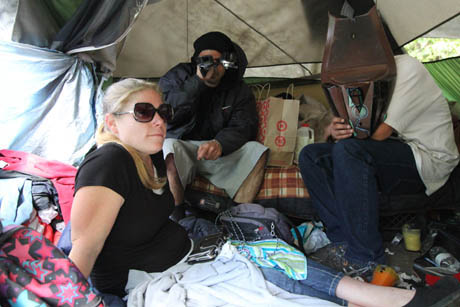The beginning of the New Year is a time for resolutions and “Top Ten” wishlists. This is my Bill Wilson Center wish list for addressing some of the major issues around homelessness for our youth.
2014 HOMELESS YOUTH TOP-10 WISH LIST:
10. SINGLE-ROOM OCCUPANCY UNITS (SROS) AT COMMUNITY COLLEGES
We are home to some of the finest community colleges in the nation, featuring certification programs that provide the knowledge and skills needed by homeless youth to turn around their lives. Prior to joining college, our young people need places to call home. With the expansive real estate at the campuses disposal, a row of parking spaces could be replaced with single-occupancy housing units for full-time students who had previously been living on the streets for a term not exceeding three years.
9. EDUCATE THE PUBLIC ON YOUTH HOMELESSNESS BY PUTTING A FACE TO THE PROBLEM AND PROVIDE SOLUTIONS
Just as there have been advertising campaigns created to educate the public about smoking, aids and drunk driving, a media campaign could be launched that is designed to demystify who is homeless and why they become homeless in our community. Additional information on what the public can do to help solve the problem would be great.
8. ADD FAMILY ADVISORY SERVICES (FAS) AT EVERY SCHOOL TO DIVERT FAMILY HOMELESSNESS
Bill Wilson Center has developed a simple, cost-effective program to help prevent families from becoming homeless by providing outreach and case management services at schools. FAS prevention programs focus on linking at-risk households to available community resources and helps them learn problem-solving skills to prevent future crises. It also keeps kids in school and focused on learning instead of worrying about family problems.
7. COMMUNICATION ACCESS FOR HOMELESS YOUTH
We are living in a communications age and being connected to the system is vital for everyone to thrive. Homeless youth need P.O. boxes, voicemail and email access to apply for jobs. They also need to receive health reports and reconnect with their network of supportive friends, families and service providers.
6. FREE CLIPPER CARD PASSES FOR HOMELESS YOUTH
Clipper Cards are the all-in-one transit card in the Bay Area. The Cards would allow homeless youth to get to and from job opportunities, to and from service and health providers, and to and from school.
5. AFFORDABLE HOUSING INSTEAD OF INCARCERATION
According to the Urban Strategies Council, California’s Department of Juvenile Justice spends more than $200,000 to incarcerate a youth for one year. Studies estimate the cost of chronic homelessness in the United States, for one person over one year, range from $35,000 to $150,000. The same studies show the cost of providing hous¬ing and support for that same person ranges between $13,000 and $25,000 per year, according to the United States Interagency Council on Homelessness. There is no debate where the value is for our taxpayers.
4. EMPLOYMENT OPPORTUNITIES FOR YOUTH
As the economy recovers, too many unemployed youth with low education and experience levels face a difficult job market. Nearly 7 million youth nationwide are both out of work and out of school. Being homeless makes it even more difficult to land a job that pays enough to get off the streets and into permanent housing. Subsidized and transitional jobs are a proven way to give unemployed youth the opportunity to earn wages, build skills and connect to the labor market, while also giving businesses an incentive to hire new employees when they might not be able to do so otherwise. Each homeless youth in the county requires some source of steady living wage income.
3. EMPHASIZE RECONNECTING HOMELESS YOUTH TO FAMILIES AND COMMUNITY MENTORS
Youth should have a stable living situation that they won’t fear losing or having to leave. They should have solid, healthy relationships and connections with family (whether biological or not), friends, mentors and other significant people to whom they can turn in good times and bad. Youth need supportive adults who can provide guidance to them and adults who model healthy decision‐making.
2. EXPAND OUTREACH EFFORTS AND DEVELOP HIGH-LEVEL COORDINATION OF SERVICES FOR RUNAWAY AND NEWLY HOMELESS YOUTH TO PREVENT HUMAN TRAFFICKING
According to a 2009 Health and Human Services report, a teenager on the run will make contact with someone involved with human trafficking within 48 hours. Youth are the most vulnerable living on the streets, but they have the highest success rate for leaving the streets if given assistance to do so. Services to reach youth and young adults involved in human trafficking need a high-level coordinated approach to bring together law enforcement, medical services, public transportation services and community services.
1. BUILD SMALL AFFORDABLE HOUSING UNITS FOR LOW- AND LOW-MIDDLE INCOME YOUNG PEOPLE
Build one thousand single room occupancy (SRO) rental units for low-income young adults scattered throughout each city in Santa Clara County. Each SRO complex will include all the wrap-around services people need to stay in their homes and to deal with any issues that might lead to problems with housing. Services and support varies in intensity and can include:
• psychiatric and/or substance abuse treatment
• daily living skills training health, wellness and recreational activities
• help with family reconnections
• money management training
• vocational and supported employment services
• peer mentors
Sparky Harlan, Executive Director/CEO at Bill Wilson Center, is a nationally recognized advocate for youth in foster care and in the juvenile justice system, as well as homeless and runaway youth.


“Putting a face to the problem”…that is odd, this person(s) in the photo is covering their face. Uh, I wonder why that is?
The word ironic just screams out at me.